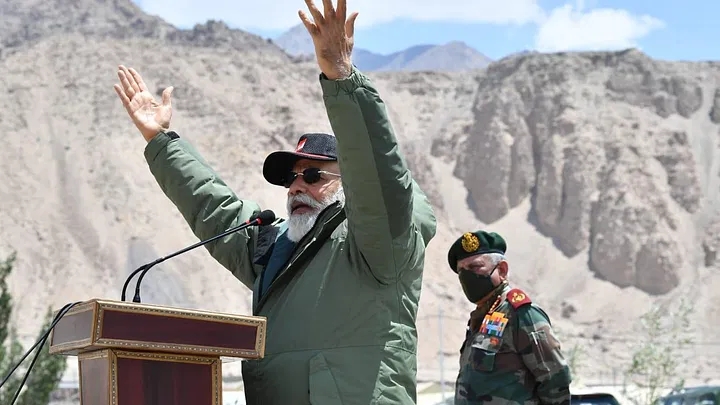

Prime Minister Modi in Ladakh|Photo credit: ANI
”We are the people who worship Lord Krishna who plays the flute. We are also the same people who follow Sudarshan Chakradhari Krishna as an ideal. With this inspiration, India has emerged stronger after every attack.”
It was with these words that Prime Minister Narendra Modi revealed his three-pronged strategy to deal with China: high level negotiations, military preparedness and economic pressure.
The strategy appears to have worked when China said on July 06, 2020 that the consensus reached with India to disengage troops at the border should be implemented as soon as possible. But uncertainty continues about the nature and timing of the disengagement.
At best, this is a semicolon and not a full stop to the India-China face-off.
Ominously, Shiv Aroor has tweeted a press report of July 13, 1962 stating that “Chinese troops withdraw from Galwan post” with the comment that “97 days after this banner headline, the 1962 war happened”.
China acknowledged that current bilateral ties were facing a “complex situation” and that both sides should adhere “to the strategic judgement that they do not pose a threat to each other”.
The talks between the Chinese Foreign Minister Wang Yi and the National Security Adviser Ajit Doval are set to continue to defuse the crisis, but the real Chinese intention is far from clear.
An Indian statement said that the two sides re-affirmed that both sides should strictly respect and observe the Line of Actual Control, and that they should not take any unilateral action to alter the status quo and work together to avoid any incident in the future that could disturb peace and tranquility in the border areas.
Right from the beginning, India had trusted the Chinese offer of negotiations after they crossed the Line of Actual Control in areas never before claimed by China.
The Defence Minister exuded confidence that the whole matter will be resolved at the military and diplomatic level. It appeared on June 15 that the Chinese were ready to withdraw from Galwan valley. But the unexpected clash of that night during the process of disengagement and the resultant casualties on both sides changed the picture altogether.
Following a statement by China that it would not withdraw from Galwan, the Prime Minister himself began to warn China that India would not hesitate to take military action to evict them.
Earlier, at an All Party Meeting, he had said that no Indian territory was under occupation in the area, primarily to keep the temperature down. After he had received indication of support from the US, France and others, the Prime Minister made a dramatic visit to Ladakh, visited the wounded soldiers and addressed the troops.
“Everyone believes that peace and friendship are important for the progress of the nation, the world and humanity. But we also know that the weak can never bring peace. The weak cannot initiate peace. Bravery is the precondition for peace… Whether it is a world war or a peace keeping effort – the world has seen the valour of our heroes and their efforts for world peace whenever needed. We have always worked for the protection of humanity. All of you are the leaders who have established this goal, tradition and this glorious culture of India,” he told the soldiers.
In a direct reference to China without mentioning it, the Prime Minister said: “The era of colonial expansion is over; this is the era of evolution. Evolution is only relevant in rapidly changing times… The world has always had this experience and on the basis of this experience, the whole world now has made up its mind against the policy of expansion. Today the world is devoted to development.”
This was the first time that the Prime Minister directly attributed Chinese incursions on the border to its expansionist policy.
Strengthening India’s defence capability was another decisive step that India took. Orders placed for advanced weaponry were speeded up and new orders were placed. The world was left in no doubt that India would not hesitate to retaliate if there is any violation of the sovereignty and territorial integrity of the country. Several countries extended support to the Indian position and agreed to speed up delivery of weapons.
The third step was in the area of reducing India’s economic involvement with China. India banned 59 Chinese lifestyle apps, which were earning massive profits in India and securing data for the Chinese government.
The ban, which has already caused mammoth losses to apps like Tik Tok, which has moved from the first position to the 200th position in 24 hours, has already caused ripples in China. The economic steps were meant to reduce our involvement with the Chinese in non-essential areas and not as a trade war.
The Chinese foreign office expressed strong concern over the move, stating that the Chinese companies follow the rules of the game wherever they go and that the host government has the responsibility to uphold the “legitimate and legal rights” of international investors.
The reaction of the Chinese Embassy in New Delhi was more harsh. “India’s measure, selectively and discriminatorily aims at certain Chinese apps on ambiguous and far-fetched grounds, runs against fair and transparent procedure requirements, abuses national security exceptions, and suspects of violating the WTO rules,” China said.
It said that the move to ban these apps, which include the hugely popular Tik Tok, WeChat and UC Browser, among others, “goes against the general trend of international trade and e-commerce, and is not conducive to consumer interests and the market competition in India”.
India’s three-pronged approach appears to have resolved the present conflict by persuading China to withdraw from the Galwan valley and the other points to restore the status quo. But it remains to be seen whether China would honour its commitment to withdraw.
Further, the fact is that the situation can stabilise only if the border between the two countries is delineated and demarcated once and for all. The decision to cooperate with China in other matters while engaging in high level discussions on the border has encouraged China to delay the border settlement and to use the time to realign the Line of Actual Control to their advantage.
The way forward is to declare the delineation and demarcation of the whole length of the border as the “core issue” between the two countries and make the settlement of the border conditional to normal relations.
The demonstration this time of our will and readiness to meet any contingency should be a lesson to China and it may be more amenable to speeding up the border settlement process.
Let us build good fences to make China a good neighbour.
